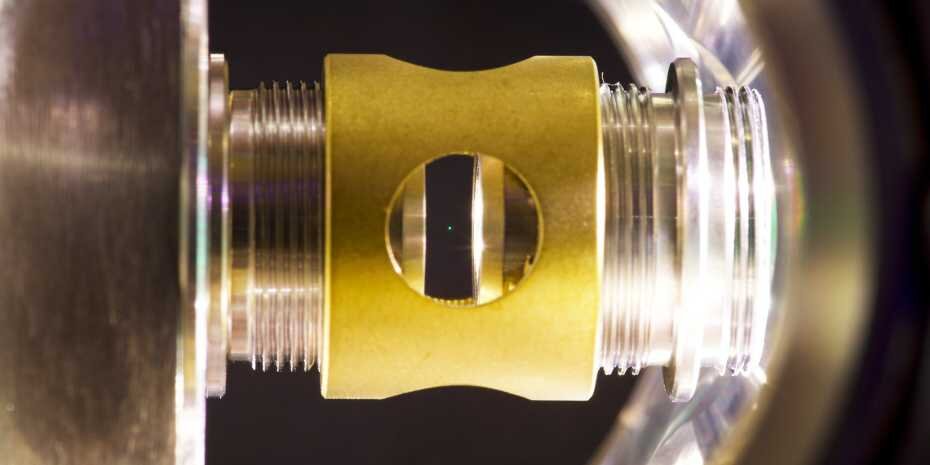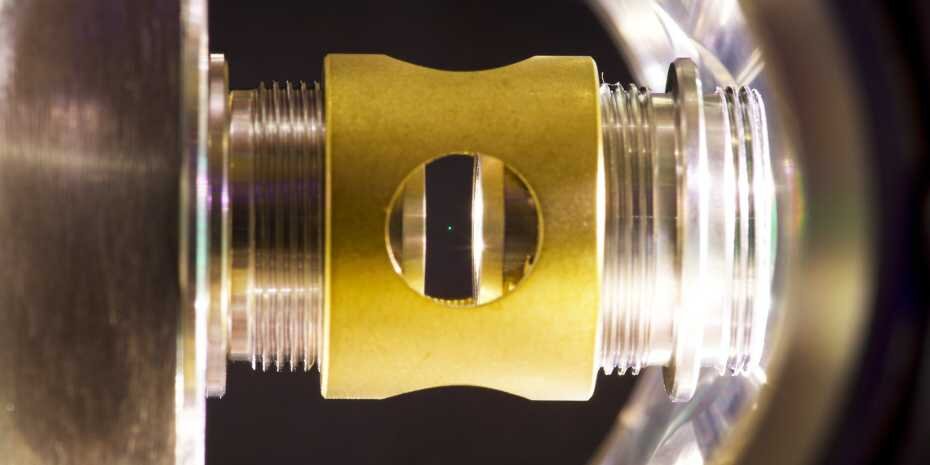Extra-Stable Light Produced by Levitated Nanoparticle
Suppressing the fluctuations inherent in a laser beam leads to light that is suited for extremely sensitive optical measurements, such as detecting gravitational waves. Most techniques for doing so require cryogenic temperatures and the complexity of an optical cavity. Now two research teams have demonstrated techniques that work without a cavity and in one case, at room temperature [1, 2]. Their approach relies on the interaction between a levitated nanoparticle and a laser beam and could lead to measurements sensitive to forces below the usual quantum detection limit.
The uncertainty principle forbids the measuring of pairs of related quantities with perfect precision. For a particle, position and momentum cannot be simultaneously determined without some uncertainty; for a light beam, it’s the amplitude (or intensity) and the phase (the timing of oscillation cycles). In experiments, this quantum limitation implies that one cannot simultaneously reduce fluctuations in these two parameters below a certain minimum level. To get around this limit, researchers reduce fluctuations of one parameter by purposefully increasing them in the other, a process called squeezing. Increasing fluctuations in one parameter can also lead to reductions in an intermediate parameter that is some combination of the two.
Squeezing requires creating a close relationship (a correlation) between the two basic parameters. For light, squeezing involves shining laser light into a medium where its amplitude affects its phase. Most recently, squeezing has been accomplished with the beam hitting a mechanical oscillator—for example, a vibrating membrane—whose oscillating amplitude, in turn, affects the phase of the fluctuating reflected light. But this approach requires a resonant optical cavity to amplify the light and boost the minuscule optomechanical interactions, along with expensive experimental infrastructure.
Now research teams led by Lukas Novotny of the Swiss Federal Institute of Technology (ETH) in Zurich and Markus Aspelmeyer of the University of Vienna have developed similar cavity-free squeezing techniques. In each experiment, a levitated silica nanosphere, 100 nanometers in diameter or less, replaces the vibrating membrane.
The nanosphere is held in an optical trap—or “optical tweezer”—produced by focusing a high intensity laser beam to a micrometer-sized spot. The researchers can arrange for the nanosphere’s random motion within the trap to be determined almost entirely by its response to the fluctuations in the trapping beam. The simplicity of this physical system makes it relatively easy to model theoretically and allowed the teams to dispense with the amplifying cavity. As with mechanical oscillators, there’s an amplitude-phase correlation: the laser’s amplitude fluctuations determine the particle’s position, and the particle’s position at any given time determines the phase of the scattered light. The interaction with the moving particle boosts the scattered light’s phase fluctuations, which leads to squeezing.
Using a microscope, the researchers collect the light scattered back toward the laser source and then use standard techniques to continuously measure its phase and amplitude. Both teams showed that fluctuations in a parameter that combines phase and amplitude were automatically reduced below what would be expected for an ordinary light beam.
In experiments at cryogenic temperatures, the ETH team measured squeezing by 25%. At room temperature, the Vienna team achieved 18%. The highest level of optomechanical squeezing achieved in cavity experiments is 42% [3]. Both teams believe that the nanoparticle approach could meet or exceed this standard. “We’re only limited by how much position information we collect,” says ETH team member Andrei Militaru.
According to Vienna team member Lorenzo Magrini, an important aspect of this light-squeezing approach—different from previous techniques—is that the light and the particle could potentially be quantum mechanically entangled. This entanglement could be used for enhanced sensing and quantum manipulation schemes for trapped particles.
“Previously, physicists had to build complex systems to boost the light-matter interaction to levels that permitted squeezed light generation,” says Lorenzo Dania, a quantum optics researcher at the University of Innsbruck, Austria. “I would not be surprised if physicists are soon able to use a levitated object and squeezed light to probe new physics,” he says.
–Rachel Berkowitz
Rachel Berkowitz is a Corresponding Editor for Physics Magazine based in Vancouver, Canada.
References
- L. Magrini et al., “Squeezed light from a levitated nanoparticle at room temperature,” Phys. Rev. Lett. 129, 053601 (2022).
- A. Militaru et al., “Ponderomotive squeezing of light by a levitated nanoparticle in free space,” Phys. Rev. Lett. 129, 053602 (2022).
- W.H.P. Nielsen et al., “Multimode optomechanical system in the quantum regime,” Proc. Natl. Acad. Sci. U.S.A. 114, 62 (2016).





